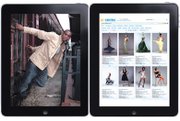The Speed of Fashion: PLM Software Aims to Make Fashion Quicker and More Efficient
First it was aerospace, then automobiles and machine manufacturing. Now, Product Lifecycle Management plans to take over the world of garment-manufacturing technology.
PLM software coordinates and manages the development of a product from design to debut on the shop floor, according to publishers of the software.
The software allows designers and manufacturers to track a product through automated production calendars, and it also offers computerized line planning, style details, material selection, costing, sampling and product testing. The first industries to embrace PLM in the 1970s were the highly bureaucratic businesses of aerospace and automobile manufacturing.
PLM was crucial to the engineers and the technicians designing and manufacturing airplanes and cars, said James Horne of Centric Software Inc., headquartered in Campbell, Calif. PLM boosted product safety and the integrity of the manufacturing because engineers were able to track the development of machinery better. Design flaws were more easily identified and fixed, said Horne, Centric’s senior vice president of marketing and product development.
By the end of the 1980s, most aerospace, automobile and machine-manufacturing companies were working with PLM, Horne said. PLM providers prospected new markets. “Where are we going to go next? Fashion is underserved,” he said.
However, the transition from the often-regimented world of automobile and plane manufacturing to the quickly changing, sometimes-chaotic world of fashion was not entirely smooth. The cultures of the industries are quite different. Fashion is not as complex; garments do not literally have all the moving parts that go into cars and planes.
However, PLM sales benefited from good timing. The industry-wide effort to get the fashion industry to adapt its technology gained momentum more than a decade ago. It occurred at a time when fashion companies were being pushed to manufacture clothes quickly—and increasingly do it overseas. PLM offered companies a way to shave days and weeks off their production calendars, said John Johnson, director of global business for apparel and retail at Siemens PLM Software.
“I’m not going to get products moving any faster without [PLM’s] upfront collaboration,” Johnson said.
PLM offered speed and an accountability not enjoyed before in fashion manufacturing, according to Drew Amann of Los Angeles fashion line Belldini.
“It streamlines everything,” Amann said. “The old way is to type [information] out, fit it, send it to China and hope that it comes back correct.”
There is no official consensus among PLM purveyors as to how much of the fashion industry has adopted this technology. Mark Burstein, president of sales and marketing for New Generation Computing Inc., estimates that more than 80 percent of fashion companies making revenues of more than $1 billion have adopted PLM. Less than half of manufacturers and retailers with revenues from $200 million to $1 billion have adopted PLM.
For small companies employing fewer than 10 people or dealing with a handful of vendors, Burstein does not recommend PLM. “[They] can handle it in spreadsheets. I don’t see the big savings until you get into the big economies of scale,” Burstein said.
Post-recession opportunities
Interest in PLM’s money-saving efficiency increased during the Great Recession, although Leslie Hand, research director of IDC Retail Insights, a market-research firm focusing on retail technology, said not all struggling companies adopted PLM. “PLM sales have picked up post-recession,” she said. “Fashion apparel brands are engaged in many other top-priority projects as well, so resources may be constrained, but interest remains strong.”
PLM is continuing to grow and adapt to the fashion industry, she said. “PLM today has so much more to do with process orchestration, content management and workflow management than it did previously,” Hand said.
PLM designers seek ways to make PLM even more accessible. Centric debuted the Centric 8 Collection Book application for the iPad. Centric recommended the iPad app as a tool for fashion buyers, who can purchase a designer’s garments moments after a runway debut. The Collection Book app is connected to the PLM system and can be used by a designer’s merchandising, sales and marketing staff to communicate directly with retailers and showrooms.
NGC is scheduled to debut its version 12.0 of its PLM at the end of May. Version 12.0 contains a supply chain–management application that will increase efficiencies of its programs.
Siemens PLM’s Teamcenter program has sought to make its product user-friendly by offering features such as calendar dashboards that can be configured by users and an integration with Microsoft programs, which allows people to use familiar Microsoft programs such as Outlook and Word with PLM.






















